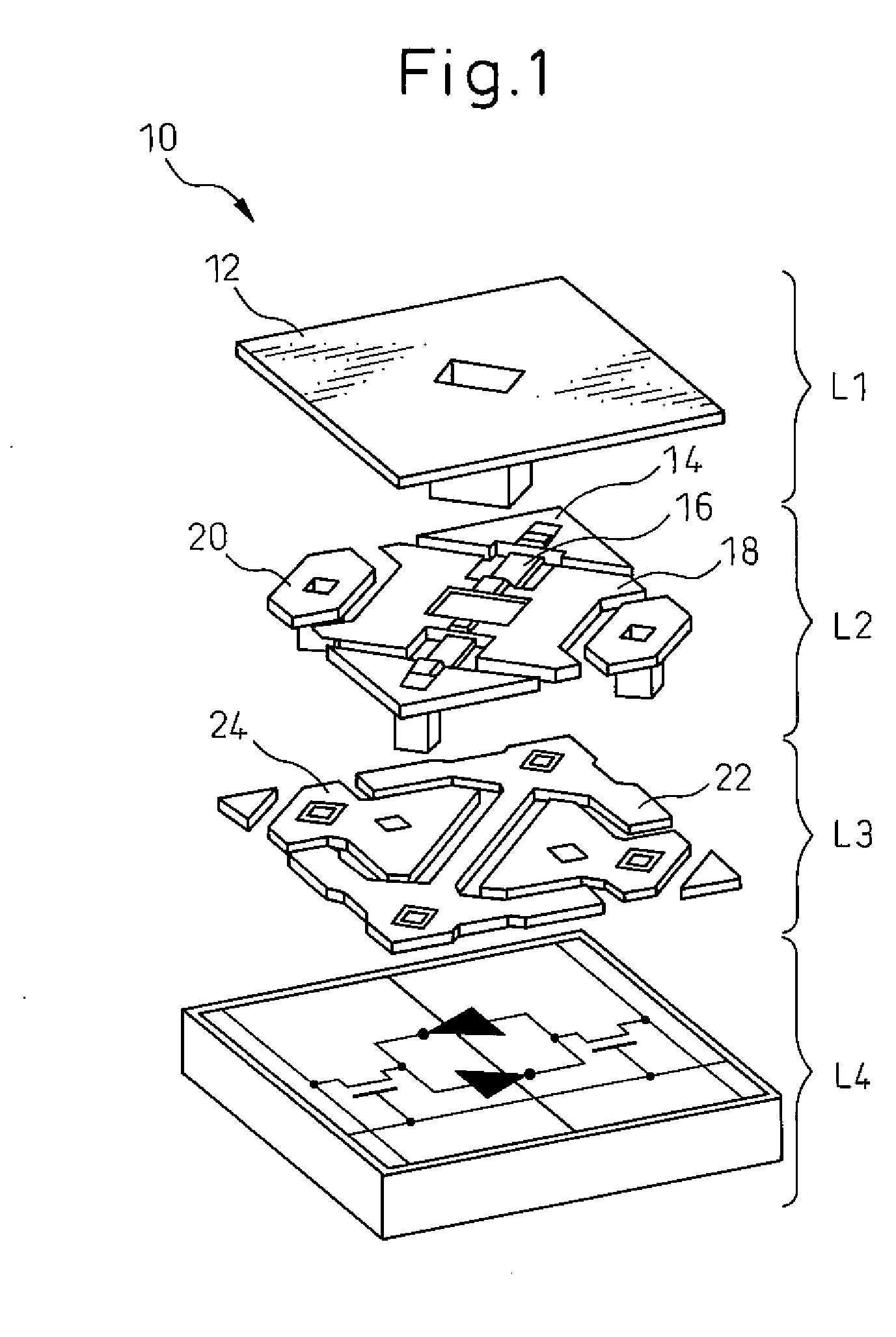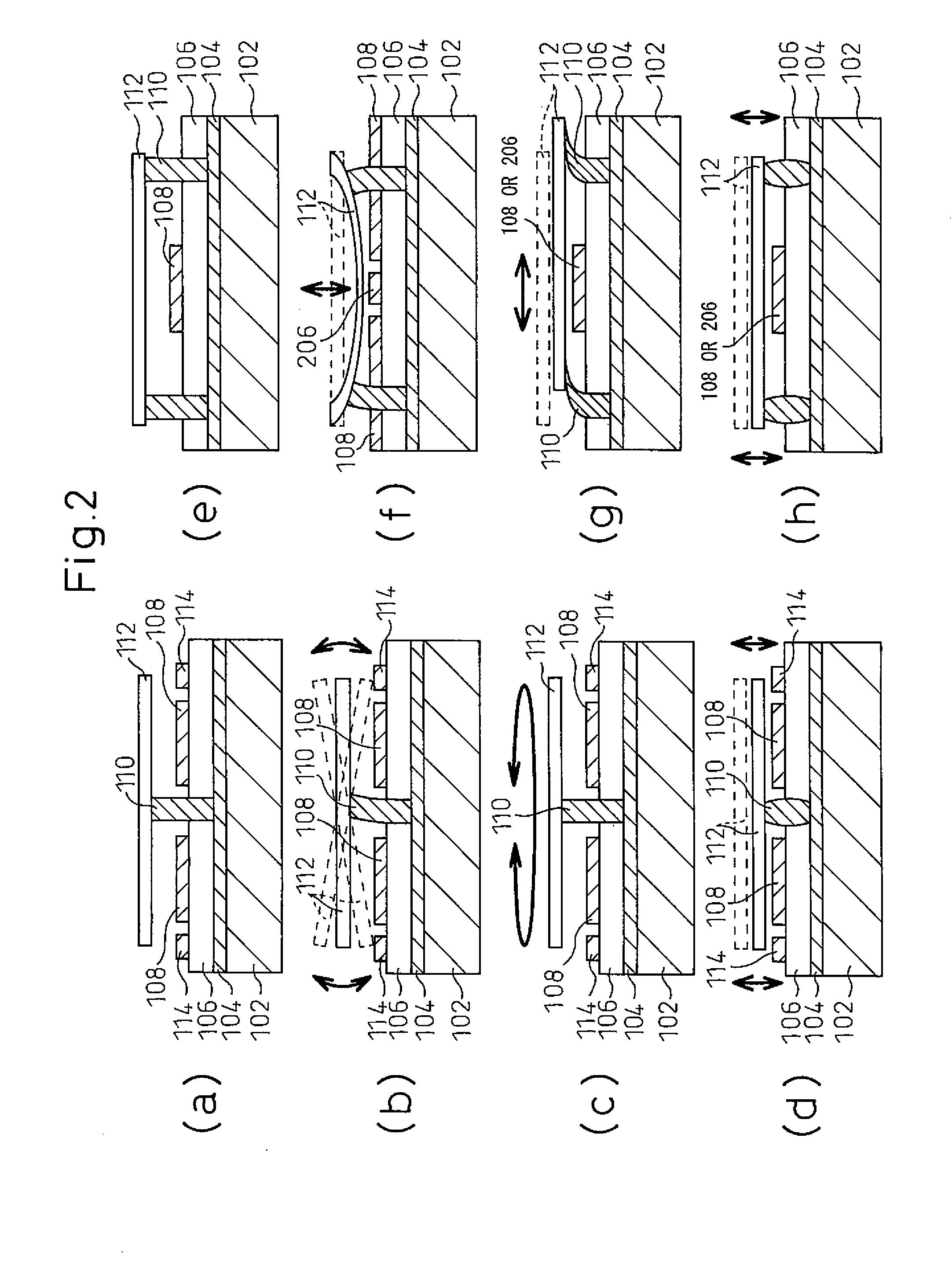Movable device
a technology of moving parts and components, applied in variable capacitors, generators/motors, instruments, etc., can solve the problems of low reliability, complicated structure, and troublesome production process
- Summary
- Abstract
- Description
- Claims
- Application Information
AI Technical Summary
Problems solved by technology
Method used
Image
Examples
embodiments
Embodiment 1
Reflection Mirror Device
[0069]FIG. 4(1) is a longitudinal cross-sectional view of a reflection mirror device of an optical MEMS using a movable device of the present invention.
[0070]The illustrated reflection mirror device 100 is comprised of a substrate 102 on which a basic conductive layer 104, insulation layer 106, and a pair of left and right bottom electrodes 108L and 108R are formed in that order. A carbon nanotube elastic shaft 110 is fixed at its bottom end to the basic conductive layer 104 and passes upward through the insulation layer 106 to stand up. The top end of this elastic shaft 110 has the top electrode 112 fixed to it. The top surface of the top electrode 112 forms a mirror surface which functions as a reflection mirror. The insulation layer 106 has the function of reinforcing the joint between the bottom end of the carbon nanotube 110 and the basic conductive layer 104 so as to enable the superior mechanical properties of the carbon nanotube to be full...
embodiment 2
Multidirection Tilt
[0099]The reflection mirror device 100 of Embodiment 1 was shown in a mode tilting to the two directions of left and right, but the invention does not have to be limited to this. A mode tilting in larger directions is also possible.
[0100]For example, as shown in FIG. 8, the bottom electrodes 108 and stopper layers 114 are arranged radially in eight directions A to H centered about the carbon nanotube elastic shaft 110. By applying voltage between any one direction bottom electrode 108 among A to H and the top electrode 112, the top electrode 112 tilts in the direction of the bottom electrode 108 to which the voltage is applied. In this way, a reflection mirror device able to selectively tilt in eight directions can be realized.
embodiment 3
Multimirror
[0101]An example of a multimirror structure comprising reflection mirror devices 100 using the optical MEMS explained in Embodiment 1 arranged in a matrix will be explained.
[0102]The LSI device 126 shown in FIG. 9(1) is prepared by a multimirror structure shown in FIG. 9(2) using part of the connection pads 128 among a large number of connection pads 128, 130 as connection pads for optical communication. The other pads 130 are used for ordinary interconnect connections.
[0103]FIG. 9(2) is a plan view of a multimirror structure comprised of the MEMS reflection mirror devices 100 of Embodiment 1 arranged in a 5×5 matrix. The fine lines S show the outer edges of the regions occupied by the individual reflection mirror devices 100 and the boundary lines between adjoining mirror devices. If using reflection mirror devices 100 of the size of Embodiment 1, the areas of the pads 128 as a whole become 6.5×6.5 μm.
[0104]The optical communication pads 128 may be used for connecting a ...
PUM
 Login to View More
Login to View More Abstract
Description
Claims
Application Information
 Login to View More
Login to View More - R&D
- Intellectual Property
- Life Sciences
- Materials
- Tech Scout
- Unparalleled Data Quality
- Higher Quality Content
- 60% Fewer Hallucinations
Browse by: Latest US Patents, China's latest patents, Technical Efficacy Thesaurus, Application Domain, Technology Topic, Popular Technical Reports.
© 2025 PatSnap. All rights reserved.Legal|Privacy policy|Modern Slavery Act Transparency Statement|Sitemap|About US| Contact US: help@patsnap.com



